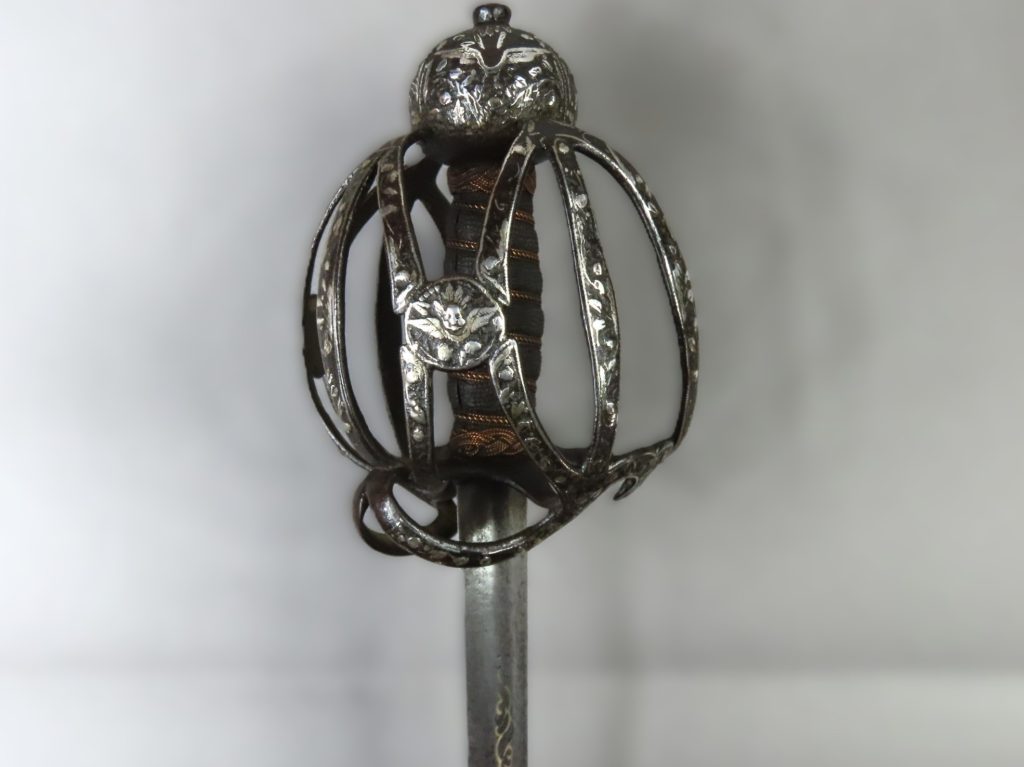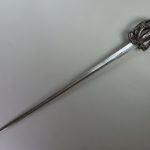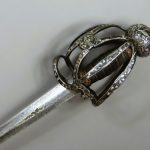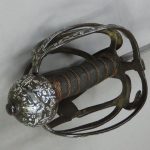
A Rare and Important early 17th century English Silver Encrusted Basket Hilted Sword
To enquire about this itemplease click here
Price: £13,500
Ref: 52082217
Item Description
A fine and attractive English Basket Hilted Sword with silver encrusted hilt dating to the late 16th or early 17th century. This rare type of hilt decoration was reserved for wealthy individuals and the nobility as contemporary portraits show. Many of the surviving examples are in institutional collections and those still in private hands rarely come up for sale. This sword is known as the “How of Edinburgh” sword due to it once being part of the G E P How Collection (for further reference see below).
The iron outer surfaces of the hilt have been chased with delicate chisel work into linear patterns, designs and shapes, including winged cherubs heads in raised relief. The hilt has then been blackened and the raised shapes encrusted with silver which markedly contrasts with the blackened background to give a striking appearance. This decorative technique required more time, skill and silver than was needed in standard silver gilding and was much more expensive to carry out. The technique was therefore only applied to the best manufactured English swords of the time including rapiers, riding swords, pillow swords and robe swords as well as basket hilted swords.
Our sword has a basket hilt which English sources refer to as “Irish”. From the English perspective the term “Irish Hilt” indicates its evolution from the basket hilted sword that was first developed in the Gaelic speaking regions of Highland Scotland and Ireland in the late 16th century. English sources grouped these people together and referred to them collectively as Irish. English armourers copied the sword style and applied their own modifications to the same hilt structure to create an English variant referred to it as “Irish” to differentiate it from other English hilt types. It was used by the English throughout the 17th century with modifications and advancements made during this time. The sword discussed here is a typical early example with a large globular pommel.
The hilt is forged from broad flattened rectangular section bars. The knuckle bow curves upwards to the pommel from the cross guard at the front. Two side guard bars curve from the cross guard in the same manner. The frontal loop guard bars are a downward continuation of the side guard bars which curve forward to join the base of the knuckle bow at the front quillon terminal.
To the front, in the spaces between the knuckle bow and the two main side guard bars, two saltire bars are centred with circular guard plates. To the back, a rear guard bar on each side curves upwards from the rear quillon to attach to the side guard bars near the pommel. Between these at the base, secondary cross bars have been applied to strengthen the structure with short downward facing posts emanating from the middle of each.
The large, globular, pommel has a shallow raised integral button on top. The wooden grip is of slightly oval cross section, spirally grooved, and covered with shagreen bound with roped copper wire and mounted with woven copper wire “Turks Heads” top and bottom.
The fine quality double edged tapering blade is of stiff flattened hollow ground diamond cross section and is 32 inches (81.5 cm) long. A latten inlaid foliate design which may be a blademaker’s mark is present on each side where the spine of the blade has been flattened to accommodate the mark for a short distance from the hilt. Overall the sword is just over 38 inches (97 cm) long overall.
The sword was once part of the GEP How Collection until circa 2007. How of Edinburgh were leading specialists in antique Scottish silver on an international scale. The business was established in 1930 by Lt-Commander G.E.P. How (Royal Navy, retired), F.S.A Scot. and his wife Jane Prentice How. He was born in Edinburgh on June 23rd 1894, and spent much of his youth with his uncle Lord Cuncliffe, who taught him about antique silver. Mrs How was a renowned expert dealer in antique Scottish silver in her own right and had a formidable scholarly and personal reputation in these circles despite her diminutive appearance.
The business operated until 1970 marked by the death of Mr How. Afterwards Mrs How continued the business after on a reducing scale. She enjoyed considerable influence in the antiques trade and had a solid reputation for her knowledge and integrity right up to her death in 2004. The sword was released from Mrs How’s estate in 2007 when it was sold at Lyon & Turnbull auctions in Edinburgh. The sword was part of the private collection of the How family which contained a few exceptional weapons. As well as being a fine English sword it provides a reference example of early 17th century English silver onlay techniques.
For two further examples of this type of sword, as well as other English types encrusted with silver only, see a definitive paper by Leslie Southwick, “English Swords, c. 1600-c. 1660, Aspects of Design, Ornament and Manufacture”, London Park Lane Arms Fair, Apollo Publishing, Spring 2017, Pages 24 to 92. Page 74, Fig 54, illustrates a sword engraved with the arms of James I in the Victoria & Albert Museum, London (Inv. M.472-1936) and Page 75, Fig 55, illustrates a sword in Glasgow Museum and Art Gallery, Kelvingrove (Inv. A.1956.18).
See also Dr Ralph Moffat, “introducing European Arms and Armour – The Burrell Collection”, Mackay and Inglis Ltd Glasgow, page 48, for a similar sword displayed in the Burrell Collection in Scotland.
Also Stuart C Mowbray, “British Military Swords 1600 to 1660”, Mowbray Publishers, 2013, pages 110 to 126.





























